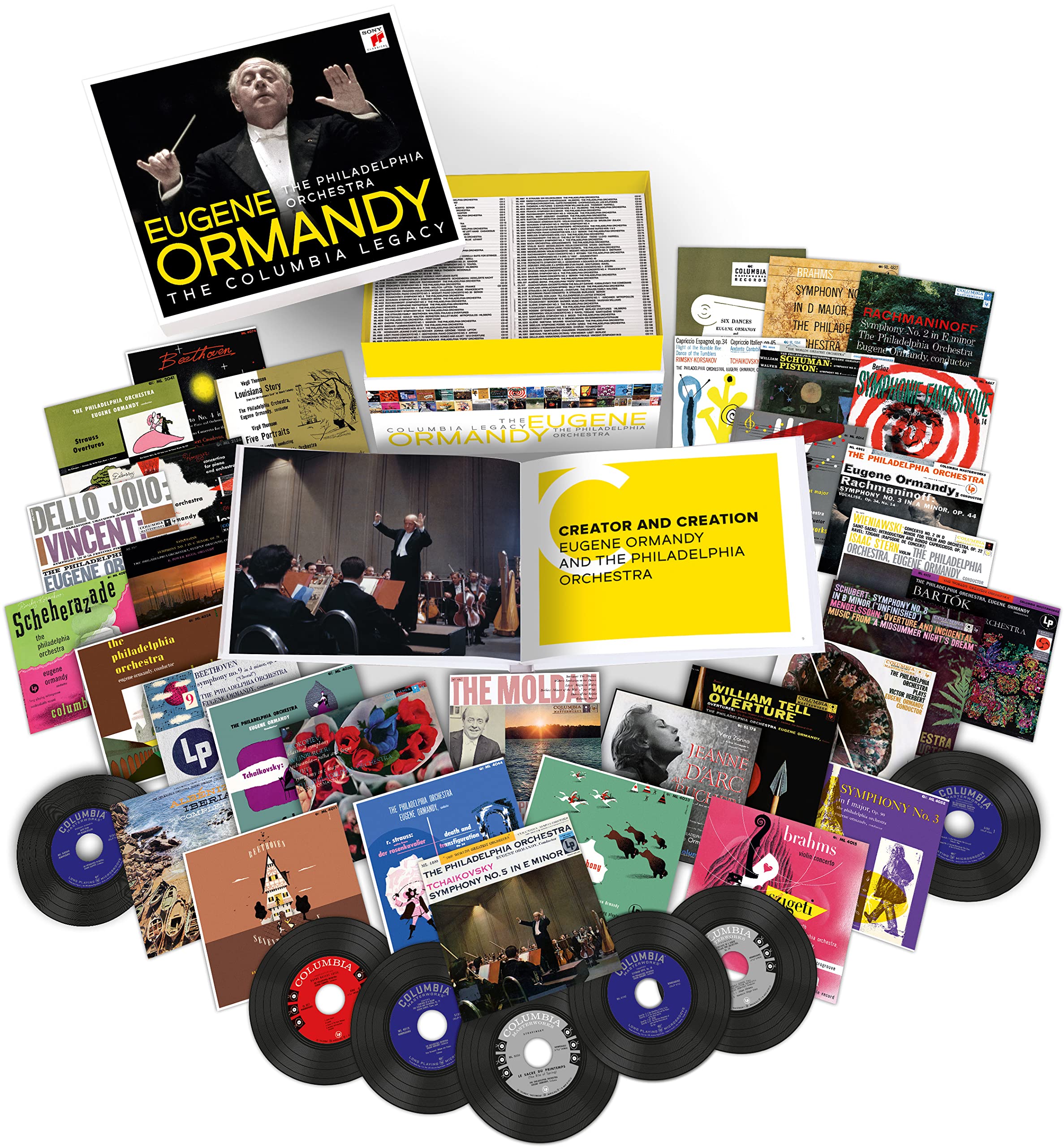Eugene Ormandy – The Columbia Legacy

Eugene Ormandy – The Columbia Legacy
Granting a long-held wish of many record collectors, Sony Classical is issuing the complete monaural American Columbia discography of Eugene Ormandy and the Philadelphia Orchestra in a vast box set of 120 CDs, all in new remasterings. Almost all of this material will be appearing for the first time on CD on Sony Classical. Indeed, 152 of these recordings have never been released at all on CD before now.
Ormandy took over the Philadelphia’s music directorship from Leopold Stokowski in 1938 and held the position for 42 years. During that time – in which his name and the orchestra’s became inseparable – he cultivated and further developed the voluptuous sound that originated with his predecessor. “Any conductor reflects clearly the instrument he played,” the Budapest-born Ormandy (1899-1985) once said. “My sound is what it is because I was a violinist.” The American composer and critic Virgil Thomson described Ormandy’s “Philadelphia sound” as “pungent and mellow like the smell of fall fruits. No other instrumental assembly has quite the quality of impersonal, almost botanical, beauty that this one possesses; and none of the other conductors who appear regularly before us has quite Eugene Ormandy’s way of offering really excellent workmanship without personal insistence.”
Ormandy and his Philadelphians were among the most prolific recording artists of all time. Between 1944 and 1968 (preceded and followed by contracts with RCA Victor), they were associated exclusively with American Columbia. Ormandy was a committed recording enthusiast, working quickly and readily accommodating the company’s planning in order to produce best-sellers. His frequent tours with the orchestra were aimed not just at added exposure but also at boosting record sales. The Philadelphia’s UK tour in 1949 marked the first time an American orchestra had performed overseas since before the war.
Over the years, Ormandy was sometimes criticized for his increasingly conservative, crowd-pleasing programming, but he was also responsible for numerous premieres in Philadelphia, championed the music of Bartók (a personal friend), and was the favored interpreter of Rachmaninoff. His 1952 Philadelphia recording of Honegger’s oratorio Jeanne d’Arc au Bûcher (the only previous version was a Belgian performance from 1943) was hailed by Gramophone as “a beautiful American performance (in French) on finely engineered records. Vera Zorina [as Joan of Arc].caught me off guard and moved me greatly”. As amply demonstrated in this massive new Sony Classical edition, the conductor frequently performed 20th-century composers in Philadelphia and premiered many works by American composers including Samuel Barber, Aaron Copland, Howard Hanson, Roy Harris, Vincent Persichetti, Walter Piston and Virgil Thomson and Richard Yardumian, all represented in the new box.
One of Ormandy’s earliest Columbia recordings, dating from 1944 and never before transferred to CD, is a wartime rarity, the patriotic four-movement Symphonic Suite My Country at War by the Leipzig-trained Harl McDonald (1899-1955), who was also the Philadelphia Orchestra’s general manager. The Latvian-born composer Louis Gesensway was a violinist in the orchestra. His “symphonic poem for large orchestra, narrator and street-criers” Four Squares of Philadelphia (1948-51) evokes the four famous expanses of grass and trees laid out in 1681 by William Penn, founder of the “City of Brotherly Love”. Other recordings of American repertoire in the new set making their CD debut include William Schuman’s Third Symphony and four works commissioned by the orchestra from the Philadelphia-based composer Richard Yardumian: his Armenian Suite, Desolate City, the Second Symphony “Psalms” for tenor and orchestra, and the Violin Concerto (with soloist Anshel Brusilow).
Sony Classical’s new Ormandy/Philadelphia box is filled with familiar and unfamiliar works by virtually every major composer from Bach to Beethoven to Brahms to Berg to Bartók to Bernstein and beyond. It would be impossible (and pointless) to list them all, but just citing some of those recordings that have never before been released on CD gives a good idea of the breadth of repertoire contained here. Symphonies include the Franck D minor and Beethoven’s Ninth (both recorded in 1945), Brahms’s Third (1946), Tchaikovsky’s Fourth (1947), Haydn 99 “Clock” (1949), Haydn 100 “Military”, Brahms’s First and the Berlioz Fantastique (all three from 1950), and Beethoven’s Fifth (1955).
Recordings of suites new to CD include Handel’s Water Music (in Ormandy’s own arrangement) and Kodaly’s Háry János (both from 1946), Ravel’s two suites from Daphnis et Chloé (with the Temple University Choir; 1949-50) Offenbach’s Gaîté Parisienne and Chopin Les Sylphides (both from 1954), Grieg’s Peer Gynt and Bizet’s L’Arlésienne (both from 1955) and Khachaturian’s Gayne and Kabalevsky’s Comedians (both from 1956). Other CD premieres include Debussy’s Nocturnes (recorded in 1944), Respighi’s Pines of Rome and Roman Festivals (1946) and Rapsodie espagnole (1950), the Mussorgsky-Ravel Pictures at an Exhibition and Wagner Overtures (both from 1953), and Strauss’s Ein Heldenleben (1954).
Ormandy’s Austro-Hungarian roots and experience as a conductor of light music made him a natural interpreter of Viennese waltzes and polkas. He and his Philadelphia musicians recorded music by the Strauss family almost every year between 1951 and 1958 (“It is a real joy to hear such facility and drive coupled with lightness and clarity” – High Fidelity). Sony is also including Ormandy’s complete 1950 recording of Die Fledermaus from the Metropolitan Opera, sung in English, with Ljuba Welitsch as Rosalinde, Charles Kullman as Eisenstein, Lily Pons as Adele and Richard Tucker as Alfred.
Many classic concerto recordings came out of Philadelphia in the 1940s and 50s. They are all to be found in the new set, beginning in 1944 with Lalo’s Symphonie espagnole (“Ormandy knows the terrain perfectly, bringing the winds forward when required and drawing out the lower strings powerfully: it helps to have so superbly virtuoso an instrument at the Philadelphia Orchestra playing, of course. [Nathan] Milstein remains.the embodiment of perfect violin playing” – MusicWeb International). Pianist Rudolf Serkin was in his prime and one of Columbia’s foremost artists in this period. He can be heard in the Schumann Concerto from 1946 (“Probably the best all-around version available” – Gramophone’s original review from 1948), the five by Beethoven (1953-58), Brahms No. 2 (1945 and again in 1956) and the Strauss Burleske (1955 – “The pianist’s stunning mono version.a riproaring virtuosic tour de force if there ever was one” – Gramophone). More Beethoven piano concertos from Robert Casadesus (No.4; 1947) and Claudio Arrau (No. 3; 1947) and, also from Arrau, Liszt’s First Concerto and Hungarian Fantasia (1952). György Sándor premiered and made the first recording of the Third Piano Concerto by his teacher and friend Béla Bartók in Philadelphia in 1946, the year after the composer’s death. It is reissued here along with Sándor’s recording of the Chopin First Concerto from 1952. There are Brahms Violin Concertos with Joseph Szigeti (1945) and Zino Francescatti (1956), the Violin Concertos of Tchaikovsky (1949) and Mendelssohn (1950) with Isaac Stern, the Dvorák Cello Concerto (1946) with Gregor Piatigorsky, and so much more.
In his obituary of the conductor in 1985, the American critic Thor Eckert Jr. wrote that “the Ormandy style came to its apex in the Russian repertoire. His interpretations of Rachmaninoff, Prokofiev, Tchaikovsky, Rimsky-Korsakoff, and Shostakovich were incomparable”. Sony Classical’s new edition includes Ormandy’s recordings of all these composers, none more famous than his readings of works by his close friend Sergei Rachmaninoff: the Second and Third Symphonies (recorded in 1951), The Bells
| SKU: | B08QRXT715 |
| Dimensions: | 33.2 x 27.5 x 19.7 cm; 6.5 Kilograms |
| Manufacture: | Sony Music Classical |
| Origin: | United Kingdom |
